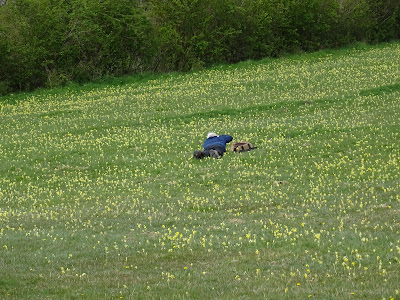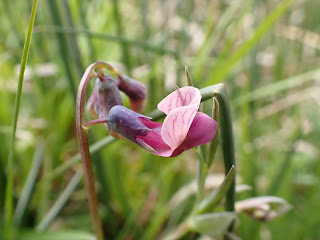Wednesday 24th April, Prince’s Rough
The sun was shining brightly as we gathered in the Burial Ground car park in Westhope.
After a slight delay we set off to reach Prince’s Rough.
When we were about halfway, we realised that the two of us within the group who knew about the site were not sure how to get there!
After a brief pause while we waited for some back markers to catch us up (!) we took the opportunity to do a quick explore to check the route.
Once we were all gathered together again, and confidence restored that we knew the way, we strode on towards the site, passing some sheep (possibly Herdwick’s) who took an interest in what we were up to.
 |
| Photograph: John Martin |
We ascended to the top of the small hill, passing a large farmyard muck pile (that no-one ventured near), then gazed upon our destination which was at the foot of the hill ascending up the next gentle slope.
Prince’s Rough is designated a SSSI as a traditionally managed herb-rich hay meadow. It is situated on the dip slope of Wenlock. According to the SSSI citation, the meadow contains many locally uncommon and scarce plants. There is a wet area associated with a redundant ditch and a small seasonal pool at the southern end of the meadow which add to the overall diversity of the flora.
And what a sight it was when it came into view, with thousands of yellow dots against a green background provided by the multitude of cowslips.
We entered the site through a gate and set about doing what we normally do: observing; sweep netting, beating, suction sampling; grubbing around; photographing; chatting; eating and identifying what we found – not necessarily in this order of time spent – until it was time to return home.
I will let the photographs provide most of the day’s story.
The first meadow that we came on entering the site.
On the right as we entered several Mesembrina meridiana were resting on a tree trunk.
 |
| Photograph: John Martin |
Beaten from the vegetation, an Angle shades moth larva.
 |
| Photograph: David Williams |
From the same vegetation a Slender ground hopper.
 |
| Photograph: David Williams |
In amongst the Cowslips one of several Adder’s-tongue ferns. It has acquired its name as the projecting stalk that bears the fern’s spores resembles a snake’s tongue, and the leaf a snake’s head.
 |
| Photograph: David Williams |
Whilst most of us pottered about this first meadow one member returning after injury soon displayed glimpses of his old form in the second meadow.
Cowslips!
 |
| Photograph: John Martin |
A sign of spring, mating craneflies, Euphylidorea dispar.
Another sign, blossom about to burst forth.
A Wainscot species larva.
 |
| Photograph: David Williams |
Moving into the second meadow, if anything the cowslips were even more abundant. Interspersed with them were Early-purple orchids.
 |
| Photograph: David Williams |
 |
| Photograph: John Bingham |
Beating the hedgerow dislodged several small Figure of Eight moth larvae. Here is one of them.
 |
| Photograph: David Williams |
A ground beetle, Oxyselaphus obscurus.
 |
| Photograph: Nigel Cane-Honeysett |
More signs of Spring, a pair of staphylinid beetles, probably Stenus similis.
%20NCH%202024-04-24.jpg) |
| Photograph: Nigel Cane-Honeysett |
A Dotted bee-fly at rest.
 |
| Photograph: David Williams |
And a Dotted bee-fly feeding at a cowslip.
 |
| Photograph: David Willims |
A tiny “wiglet”, the first instar of a Common earwig.
 |
| Photograph: David Williams |
A view showing the second meadow with Flounder’s Folly on top of the hill in the distance.
 |
| Photograph: David Williams |
Entering some woodland we were met by this strange arrangement.
 |
| Photograph: Nigel Cane-Honeysett |
Returning to the meadow a fungus was spotted, Ophiocordycipitaceae gracilis. This develops within the buried larva of a caterpillar then erupts from it when it flowers. The photograph is not of the one found but one found on an earlier occasion.
 |
| Photograph: John Bingham |
And finally, someone had to do it!
 |
| Photograph: John Martin |
To sum up, a comment from one of the attendees, "A splendid day and at times almost warm!"
My thanks to the site manager for allowing us to do what we enjoy doing. My gratitude to the photographers for sending me their excellent images to illuminate the report.









.jpg)




















.JPG)
.JPG)


























